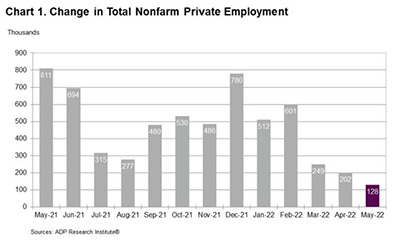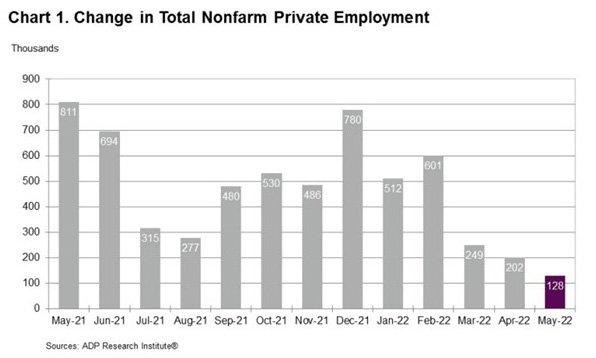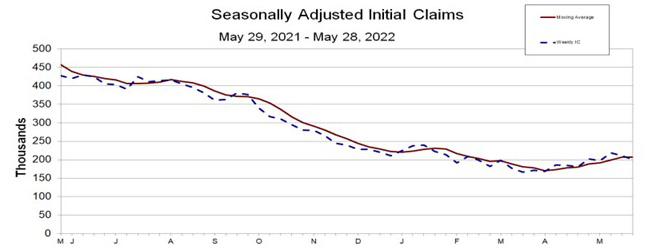
Private-Sector Employment Slows; Initial Claims Fall to 53-Year Low

ADP, Roseland, N.J., on Thursday said private-sector employment came in below expectations. Meanwhile, the Labor Department reported initial claims for unemployment insurance fell to their lowest levels since 1969.
The ADP National Employment Report said private-sector employment increased by 128,000 jobs from April to May. By company size, small businesses (1-49 employees) saw a 91,000 decline; medium businesses (50-499 employees) saw a 97,000 increase, while large businesses reported an increase of 122,000.

By sector, ADP reported goods-producing businesses added 24,000 jobs, while service-providing businesses added 104,000 jobs.
“Under a backdrop of a tight labor market and elevated inflation, monthly job gains are closer to pre-pandemic levels,” said Nela Richardson, chief economist with ADP. “The job growth rate of hiring has tempered across all industries, while small businesses remain a source of concern as they struggle to keep up with larger firms that have been booming as of late.”
Meanwhile, the Labor Department said for the week ending May 28, the advance figure for seasonally adjusted initial claims fell to 200,000, a decrease of 11,000 from the previous week, which revised up by 1,000 from 210,000 to 211,000. The four-week moving average was 206,500, a decrease of 500 from the previous week’s revised average.

The advance seasonally adjusted insured unemployment rate fell to 0.9 percent for the week ending May 21, a decrease of 0.1 percentage point from the previous week’s unrevised rate. The advance number for seasonally adjusted insured unemployment during the week ending May 21 fell to 1,309,000, a decrease of 34,000 from the previous week’s revised level to its lowest rate since December 27, 1969, when it was 1,304,000. The four-week moving average fell to 1,327,250, a decrease of 19,500 from the previous week’s revised average to its lowest level since January 10, 1970, when it was 1,310,250.
The advance number of actual initial claims under state programs, unadjusted, totaled 182,327 in the week ending May 28, a decrease of 2,921 (1.6 percent) from the previous week. The seasonal factors had expected an increase of 7,182 (or 3.9 percent) from the previous week. Labor reported 430,171 initial claims in the comparable week in 2021.
The advance unadjusted insured unemployment rate was unchanged at 0.9 percent during the week ending May 21. The advance unadjusted level of insured unemployment in state programs totaled 1,259,162, a decrease of 31,222 (2.4 percent) from the preceding week. The seasonal factors had expected an increase of 1,343 (0.1 percent) from the previous week. A year earlier the rate was 2.5 percent; volume was 3,499,487.
The total number of continued weeks claimed for benefits in all programs for the week ending May 14 was 1,319,297, an increase of 2,113 from the previous week. Labor reported 15,456,735 weekly claims filed for benefits in all programs in the comparable week in 2021.
This morning, the Bureau of Labor Statistics releases its Employment Report (8:30 a.m. ET). MBA Chief Economist Mike Fratantoni will provide commentary and analysis on the Employment report in the Monday, June 6 edition of MBA NewsLink.
